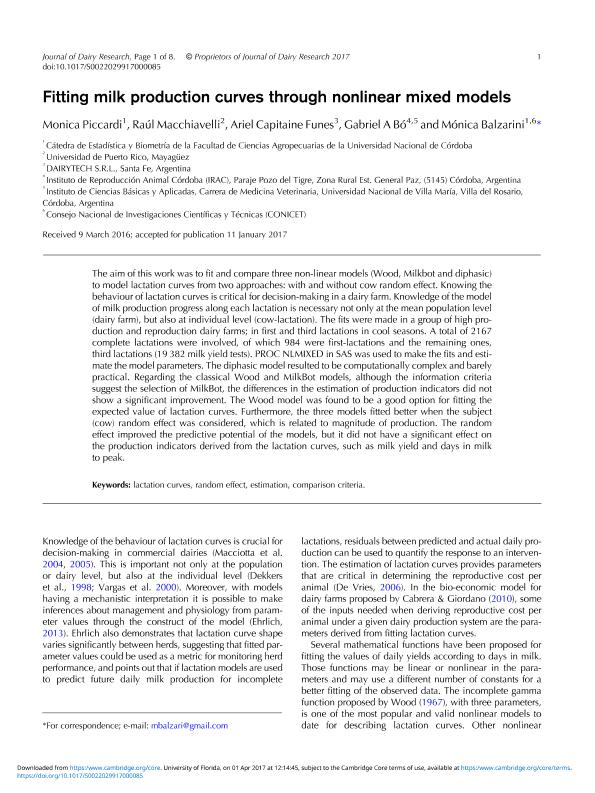Mostrar el registro sencillo del ítem
dc.contributor.author
Piccardi, Mónica Belén

dc.contributor.author
Macchiavelli, Raúl
dc.contributor.author
Funes, Ariel Capitaine
dc.contributor.author
Bó, Gabriel A.
dc.contributor.author
Balzarini, Monica Graciela

dc.date.available
2020-02-12T20:16:31Z
dc.date.issued
2017-05
dc.identifier.citation
Piccardi, Mónica Belén; Macchiavelli, Raúl; Funes, Ariel Capitaine; Bó, Gabriel A.; Balzarini, Monica Graciela; Fitting milk production curves through nonlinear mixed models; Cambridge University Press; Journal of Dairy Research; 84; 2; 5-2017; 146-153
dc.identifier.issn
0022-0299
dc.identifier.uri
http://hdl.handle.net/11336/97338
dc.description.abstract
The aim of this work was to fit and compare three non-linear models (Wood, Milkbot and diphasic) to model lactation curves from two approaches: with and without cow random effect. Knowing the behaviour of lactation curves is critical for decision-making in a dairy farm. Knowledge of the model of milk production progress along each lactation is necessary not only at the mean population level (dairy farm), but also at individual level (cow-lactation). The fits were made in a group of high production and reproduction dairy farms; in first and third lactations in cool seasons. A total of 2167 complete lactations were involved, of which 984 were first-lactations and the remaining ones, third lactations (19 382 milk yield tests). PROC NLMIXED in SAS was used to make the fits and estimate the model parameters. The diphasic model resulted to be computationally complex and barely practical. Regarding the classical Wood and MilkBot models, although the information criteria suggest the selection of MilkBot, the differences in the estimation of production indicators did not show a significant improvement. The Wood model was found to be a good option for fitting the expected value of lactation curves. Furthermore, the three models fitted better when the subject (cow) random effect was considered, which is related to magnitude of production. The random effect improved the predictive potential of the models, but it did not have a significant effect on the production indicators derived from the lactation curves, such as milk yield and days in milk to peak.
dc.format
application/pdf
dc.language.iso
eng
dc.publisher
Cambridge University Press

dc.rights
info:eu-repo/semantics/openAccess
dc.rights.uri
https://creativecommons.org/licenses/by-nc-sa/2.5/ar/
dc.subject
COMPARISON CRITERIA
dc.subject
ESTIMATION
dc.subject
LACTATION CURVES
dc.subject
RANDOM EFFECT
dc.subject.classification
Otras Producción Animal y Lechería

dc.subject.classification
Producción Animal y Lechería

dc.subject.classification
CIENCIAS AGRÍCOLAS

dc.title
Fitting milk production curves through nonlinear mixed models
dc.type
info:eu-repo/semantics/article
dc.type
info:ar-repo/semantics/artículo
dc.type
info:eu-repo/semantics/publishedVersion
dc.date.updated
2020-02-12T17:49:18Z
dc.journal.volume
84
dc.journal.number
2
dc.journal.pagination
146-153
dc.journal.pais
Reino Unido

dc.journal.ciudad
Cambridge
dc.description.fil
Fil: Piccardi, Mónica Belén. Consejo Nacional de Investigaciones Científicas y Técnicas; Argentina. Universidad Nacional de Córdoba. Facultad de Ciencias Agropecuarias. Departamento de Desarrollo Rural. Area de Estadística y Biometría; Argentina
dc.description.fil
Fil: Macchiavelli, Raúl. Universidad de Puerto Rico; Puerto Rico
dc.description.fil
Fil: Funes, Ariel Capitaine. DAIRYTECH; Argentina
dc.description.fil
Fil: Bó, Gabriel A.. Universidad Nacional de Villa María; Argentina. Instituto de Reproducción Animal Córdoba; Argentina
dc.description.fil
Fil: Balzarini, Monica Graciela. Consejo Nacional de Investigaciones Científicas y Técnicas; Argentina. Universidad Nacional de Córdoba. Facultad de Ciencias Agropecuarias. Departamento de Desarrollo Rural. Area de Estadística y Biometría; Argentina
dc.journal.title
Journal of Dairy Research

dc.relation.alternativeid
info:eu-repo/semantics/altIdentifier/doi/http://dx.doi.org/10.1017/S0022029917000085
dc.relation.alternativeid
info:eu-repo/semantics/altIdentifier/url/https://www.cambridge.org/core/journals/journal-of-dairy-research/article/fitting-milk-production-curves-through-nonlinear-mixed-models/77F777E343DA0569EE3C9DA66C55B951
Archivos asociados
